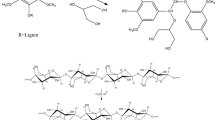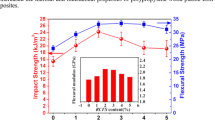Abstract
Polyurethane (PU) is one of the most important synthetic resins which have been widely used in various industries. Most of the PU resins are prepared by reacting isocyanate with polyols. Polyhydric alcohol liquefied biomasses are rich in hydroxyl groups and are considered having the potential to be a raw material for preparing PU resins. In this study, wood of Japanese cedar (Cryptomeria japonica) was liquefied in polyethylene glycol/glycerol co-solvent with H2SO4 as a catalyst at 150 °C for 60 min. After being cooled, the liquefied product was diluted, neutralized, filtered and vacuum distilled to obtain the liquefied wood (LW). Thermoplastic PU resin (TPU) containing LW was prepared by reacting a mixture of polytetramethylene ether glycol (PTMG) and LW with different OH/OH molar ratios with 1,6-hexamethylene diisocyanate (HDI), using 1,4-butanediol as a chain extender. The influence of the amount of LW on the molecular structure, mechanical and thermal properties of TPU was investigated. FTIR analysis shows that LW-containing TPU, referred to as LWTPU, has more hydrogen bonding than neat TPU. Resin films made from LW-TPU prepared with a mixture of PTMG/LW with an OH/OH molar ratio of 80/20 and 65/35 have higher tensile strength and less breaking elongation than that of neat TPU. DMA results show introducing LW leads to TPU films being more rigid. TGA results show the thermal stability of TPU films can be enhanced by LW before the temperature reaches 350 °C.






Similar content being viewed by others
References
Alma MH, Shiraishi N (1998) Preparation of polyurethane-like foams from NaOH-catalyzed liquefied wood. Holz Roh Werkst 56:245–246
Araújo RCS, Pasa VMD, Melo BN (2015) Effect of biopitch on the properties of flexible polyurethane foams. Eur Polym J 41:1420–1428
ASTM D638-14 (2014) Standard test method for tensile properties of plastics. ASTM International, West Conshohocken
Cervantes-Uc JM, Moo Espinosa JI, Cauich-Rodírguez JV, Ávila-Ortega A, Vázquez-Torres H, Marcos-Fernández A, San Román J (2009) TGA-FTIR studies of segmented aliphatic polyurethanes and their nanocomposites prepared with commercial montmorillonites. Polym Degrad Stabil 94:1666–1677
Chattopadhyay DK, Raju KVSN (2007) Structural engineering of polyurethane coatings for high performance applications. Prog Polym Sci 32:352–418
Chen F, Lu Z (2009) Liquefaction of wheat straw and preparation of rigid polyurethane foam from the liquefaction products. J Appl Polym Sci 111:508–516
Cheumani-Yona AM, Budija F, Hrastnik D, Kutnar A, Pavlič M, Pori P, Tavzes Č, Petrič M (2015) Preparation of two-component polyurethane coatings from bleached liquefied wood. Bioresources 10:3347–3363
Coleman MM, Lee KH, Skrovanek DJ, Painter PC (1986) Hydrogen bonding in polymer. 4. Infrared temperature studies of a simple polyurethane. Macromolecules 19:2149–2157
Desai SD, Emanuel AL, Sinha VK (2003) Biomaterial based polyurethane adhesive for bonding rubber and wood Joints. J Polym Res 10:275–281
Dutta S, Karak N (2006) Effect of the NCO/OH ratio on the properties of Mesua Ferrea L. seed oil modified polyurethane resins. Polym Int 55:49–56
Gurunathan T, Mohanty S, Nayak SK (2014) Preparation and performance evaluation of castor oil-based polyurethane prepolymer/polylactide blends. J Mater Sci 49:8016–8030
Hrastnik D, Humar M, Kričej B, Pavlič M, Pori P, Cheumani-Yona AM, Petrič M (2014) Polyurethane coatings from liquefied wood containing remains of a copper-, chromium-, and boron-based wood preservative. J Appl Polym Sci 131:1–9
Hu S, Wan C, Li Y (2012) Production and characterization of biopolyols and polyurethane foams from crude glycerol based liquefaction of soybean straw. Bioresour Technol 103:227–233
Huang SL, Lai JY (1997) Structure tensile properties of polyurethanes. Eur Polym J 33:1563–1567
Jayakannan M, Ramakrishnan S (2000) Effect of branching on the thermal properties of novel branched poly(4-ethyleneoxy benzoate). J Polym Sci Polym Chem 38:261–268
Juan YM, Lee WJ (2009) Properties of polyhydric alcohol liquefied wood and bark of Cryptomeria japonica and their utilization in the manufacturing of rigid PU foams. Q J Chin For 42(1):137–150 (In Chinese)
Juhaida MF, Paridah MT, Hilmi MM, Sarani Z, Jalaluddin H, Mohamad Zaki AR (2010) Liquefaction of kenaf (Hibiscus cannabinus L.) core for wood laminating adhesive. Bioresour Technol 101:1355–1360
Kumar S, Hablot E, Moscoso JLG, Obeid W, Hatcher PG, DuQuette BM, Graiver D, Narayan R, Balan V (2014) Polyurethanes preparation using proteins obtained from microalgae. J Mater Sci 49:7824–7783
Kumar A, Petrič M, Kriej B, Žigon J, Tywoniak J, Hajek P, Škapin AS, Pavlič M (2015) Liquefied-wood-based polyurethane-nanosilica hybrid coatings and hydrophobization by self-assembled monolayers of orthotrichlorosilane (OTS). ACS Sustain Chem Eng 3:2533–2541
Kurimoto Y, Takeda M, Koizumi A, Yamauchi S, Doi S, Tamura Y (2000) Mechanical properties of polyurethane films prepared from liquefied wood with polymeric MDI. Bioresour Technol 74:151–157
Lee WJ, Lin MS (2008) Preparation and application of polyurethane adhesives made from polyhydric alcohol liquefied Taiwan acacia and China fir. J Appl Polym Sci 109:23–31
Lee WJ, Kuo ES, Chao CY, Kao YP (2015) Properties of polyurethane (PUR) films prepared from liquefied wood (LW) and ethylene glycol (EG). Holzforschung 69:547–554
Li X, Wang Z, Wang J, Liu J, Li C (2014) Preparation and properties of TPU micro/nanofibers by a laser melt-electrospinning system. Polym Eng Sci 54:1412–1417
Lin WT, Lee WJ (2017) Influences of the NCO/OH molar ratio and the silica-contained on the properties of waterborne polyurethane resins. Colloid Surf A Physicochem Eng Asp 522:453–460
Lin L, Yao Y, Shiraishi N (2001) Liquefaction mechanism of β-O-4 lignin model compound in the presence of phenol under acid catalysis. Part 1. Identification of the reaction products. Holzforschung 55:617–624
Lin L, Yao Y, Yoshioka M, Shiraishi N (2004) Liquefaction mechanism of cellulose in the presence of phenol under acid catalysis. Carbohyd Polym 57:123–129
Mondal S, Hu JL (2007) Influence of hard segment on thermal degradation of thermoplastic segmented polyurethane for textile coating application. Polym Plast Technol Eng 46:37–41
Mondal S, Memmott P, Martin D (2013) Preparation and characterization of spinifex resin-based bio-polyurethane/thermoplastic polyurethane blends. Polym Plast Technol Eng 52:1535–1541
Numata K, Srivastava RK, Finne-Wistrand A, Albertsson AC, Doi Y, Abe H (2007) Branched poly(lactide) synthesized by enzymatic polymerization: effects of molecular branches and stereochemistry on enzymatic degradation and alkaline hydrolysis. Biomacromolecules 8:3115–3125
Özgür Seydibeyoğlu M, Misra M, Mohanty A, Blaker JJ, Lee KY, Bismarck A, Kazemizadeh M (2013) Green polyurethane nanocomposites from soy polyol and bacterial cellulose. J Mater Sci 48:2167–2175
Pan H, Zheng Z, Hse CY (2012) Microwave-assisted liquefaction of wood with polyhydric alcohols and its application in preparation of polyurethane (PU) foams. Eur J Wood Prod 70:461–470
Pereira APV, Vasconcelos WL, Oréfice RL (2000) Novel multicomponent silicate-poly(vinyl alcohol) hybrids with controlled reactivity. J Non Cryst Solids 273:180–185
Petrovic ZS, Simendic JB (1985) Study of the effect of soft segment length and concentration on properties of polyetherurethanes. I. The effect on physical and morphological properties. Rubber Chem Technol 58:685–700
Qi HJ, Boyce MC (2005) Stress-strain behavior of thermoplastic polyurethanes. Mech Mater 37:817–839
Rashmi BJ, Rusu D, Prashantha K, Lacrampe MF, Krawczak P (2013) Development of water-blown bio-based thermoplastic polyurethane foams using bio-derived chain extender. J Appl Polym Sci 128:292–303
Ravey M, Pearce EM (1997) Flexible polyurethane foam. І. Thermal decomposition of a polyether-based, water-blown commercial type of flexible polyurethane foam. J Appl Polym Sci 63:47–74
Rivera-Armenta JL, Heinze T, Mendoza-Martinez AM (2004) New polyurethane foams modified with cellulose derivatives. Eur Polym J 40:2803–2812
Saetung A, Rungvichaniwat A, Tsupphayakorn-ake P, Bannob P, Tulyapituk T, Saetung N (2016) Properties of waterborne polyurethane films: effects of blend formulation with hydroxyl telechelic natural rubber and modified rubber seed oils. J Polym Res 23:264
Sánchez-Adsuar MS (2000) Infuence of the composition on the crystallinity and adhesion properties of thermoplastic polyurethane elastomers. Int J Adhes Adhes 20:291–298
Sperling LH (1992) Molecular weights and sizes. In: Introduction to physical polymer science, 2nd edn. Wiley, New York, pp 68–71
Unal S, Ozturk G, Sisson K, Lo TE (2008) Poly(caprolactone) containing highly branched segmented poly(ester urethane)s via A2 with oligomeric B3 polymerization. J Polym Sci Polym Chem 46:6285–6395
Wang L, Yang S, Wang J, Wang C, Chen L (2011) Fabrication of superhydrophobic TPU film for oil–water separation based on electrospinning route. Mater Lett 65:869–872
Wilhelm C, Gardette JL (1998) Infrared analysis of the photochemical behaviour of segmented polyurethanes: aliphatic poly(ether-urethane)s. Polymer 39:5873–5980
Williams PT, Besler S (1996) The influence of temperature and heating rate on the slow pyrolysis of biomass. Renew Energy 7:233–250
Xu J, Jiang J, Hse CY, Shupe TF (2014) Preparation of polyurethane foams using fractionated products in liquefied wood. J Appl Polym Sci 131(1–7):40096
Yamada T, Aratani M, Kubo S, Ono H (2007) Chemical analysis of the product in acid-catalyzed solvolysis of cellulose using polyethylene glycol and ethylene carbonate. J Wood Sci 53:487–493
Yilgör I, Yilgör E, Wilke GL (2015) Critical parameters in designing segmented polyurethanes and their effect on morphology and properties: a comprehensive review. Polymer 58:A1–A36
Yu CY, Lee WJ (2014) Characteristics of the glycolysis products of polyurethane foams made with polyhydric alcohol liquefied Cryptomeria japonica wood. Polym Degrad Stabil 101:60–64
Zini E, Scandola M (2011) Green composites: An overview. Polym Compos 32:1905–1615
Zou X, Qin T, Huang L, Zhang X, Yang Z, Wang Y (2009) Mechanisms and main regularities of biomass liquefaction with alcohol solvents. Energy Fuel 23:5213–5218
Acknowledgements
We thank the Ministry of Science and Technology for the financial support (NSC 98-2313-B-005-004-MY3).
Author information
Authors and Affiliations
Corresponding author
Ethics declarations
Conflict of interest
The authors declare that they have no conflict of interest.
Additional information
Publisher’s Note
Springer Nature remains neutral with regard to jurisdictional claims in published maps and institutional affiliations.
Rights and permissions
About this article
Cite this article
Lee, WJ., Chao, CY. Effect of containing polyhydric alcohol liquefied wood on the properties of thermoplastic polyurethane resins. Eur. J. Wood Prod. 76, 1745–1752 (2018). https://doi.org/10.1007/s00107-018-1338-4
Received:
Published:
Issue Date:
DOI: https://doi.org/10.1007/s00107-018-1338-4




